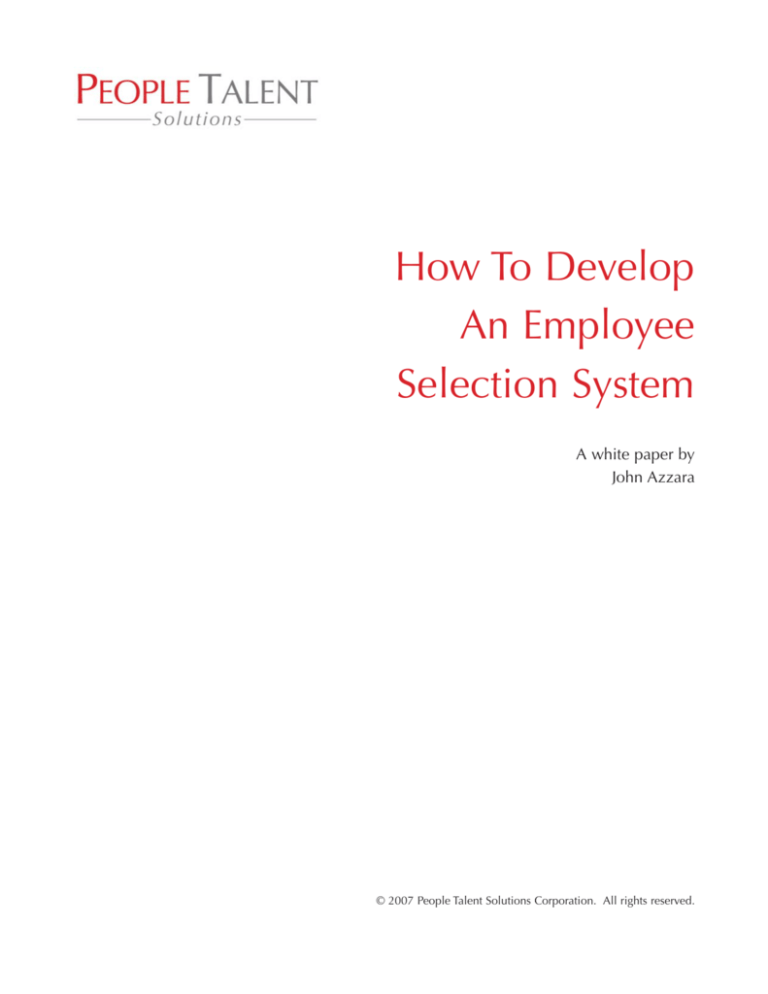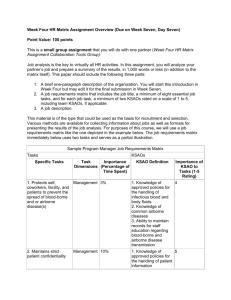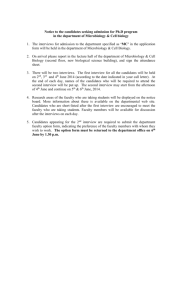
How To Develop
An Employee
Selection System
A white paper by
John Azzara
© 2007 People Talent Solutions Corporation. All rights reserved.
White Paper
How To Develop An Employee
Selection System
Employee selection systems are the processes, procedures and tools used to
make decisions related to hiring, training, placing, certifying,
compensating, promoting, terminating, transferring, and/or other actions
that affect employment status (Principles, 2003). Although selection systems
vary greatly from organization to organization, all organizations have some
form of selection system in place. The most common form of selection
system is the hiring process. Regardless of how it is used, organizations
should ensure the system is properly developed in order to gain maximum
benefit as well as minimize legal risk.
This article will discuss the five basic steps required to properly develop a
selection system: 1) analyzing the target job; 2) identifying relevant
dimensions of job performance; 3) identifying the knowledge, skills,
abilities and other factors (KSAOs) required to successfully perform the job;
4) developing tools to measure the KSAOs or locating published tools; and
5) validating tools to ensure they accurately predict performance.
Step 1: Analyzing The Target Job
Job analysis is the process whereby information about a job or position of
interest is collected. The information that is collected during this step serves
as the foundation for the remaining steps. There are a variety of methods
for collecting job information which are beyond the scope of this article.
However, the most common method is to conduct a job analysis interview.
A job analysis interview is a process in which information is gathered,
using a structured interview protocol, from a group of experts on the
position of interest.
In order to conduct a successful job analysis, advance preparation is
required. First, it is important to review as much information about the job
as possible. Examples of useful information are job descriptions, training
manuals, and on-boarding program content. Next a structured interview
2
White Paper
protocol should be prepared. Typically, a job analysis interview should
have a series of questions such as:
What is the main function of the position?
What are the key activities or tasks performed in this position?
What are the key deliverables created in this position?
How is performance determined in this position?
Describe interactions individuals in this position have with peers,
customers, subordinates, boss, etc.
What types of machinery or tools are used on the job (e.g.,
computer, jackhammer, etc.)
These questions are designed to distill the position down to its component
parts and allow the individual conducting the job interview to make
inferences about the type of individual that will perform the job
successfully.
Next, it is important to identify subject matter experts (SMEs) that have
knowledge about the position of interest. SMEs may come from a number
of places:
individuals currently doing the job (incumbents)
individuals that have done the job in the past
individuals that have considerable interaction with the job (e.g.,
technical trainers)
As a result of an effective job analysis interview, an accurate description of
the following key components of the job will be obtained:
Tasks Performed
3
White Paper
Deliverables or Products Created
Equipment Used
Working Conditions
Education and Training Required
Any other factors that characterize the position.
Step 2: Identifying Relevant Performance Criteria
The information from the job analysis interview drives the remaining steps
in the process. Although in practical application step 2 is already included
in step 1, the importance of this step warrants particular emphasis. The goal
of Step 2 is to identify the outcomes, deliverables, and/or objective
measures (e.g., sales totals, volume increase, number of products
produced, etc.) that differentiate between good performers and poor
performers. For example, in sales jobs, revenue and volume may be
important performance indicators, where good performers generate more
revenue and volume than poor performers. Although this step appears to be
straightforward, it can sometimes be difficult when analyzing certain types
of jobs. Typically, entry level jobs, sales jobs, and operations type jobs
have more tangible, objective measures of performance. On the other
hand, professional, management, and leadership jobs usually do not have
tangible performance measures. In cases where performance measures are
not as objective, supervisor and/or customer ratings of performance may be
more appropriate.
.
Step 3: Identifying KSAOs Required for Successful Job Performance
The information gathered from Steps 1 and 2 results in identification of the
knowledge, skills, abilities and other factors necessary for successful job
performance. The goal of Step 3 is to identify KSAOs that are specific to
the job being analyzed. For example, in sales jobs there may be certain
personality characteristics that are needed. Alternatively, jobs in technical
areas such as accounting or engineering may require more specific
4
White Paper
knowledge such as GAAP or physics. Although numerous books are written
on the various ways to identify KSAOs for target jobs, it is recommended
that an organization contact a professional that specializes in job analysis
to provide advice in this area.
Step 4: Developing Tools to Measure KSAOs
Once the KSAOs have been identified, it is necessary to screen candidates
on these KSAOs as part of the selection process. The most efficient way to
measure the KSAOs of job candidates is to utilize an assessment tool.
According to Gatewood and Feild (2001), assessment tools can be
classified into the following categories:
Application blanks
Biographical data forms
Reference checks
Interviews
Abilities tests
Personality inventories
Simulation and performance measures
When deciding on which assessment tools to use for any given position
there are some guidelines that should be followed. First, the assessment
tool should measure the KSAOs of interest. Second, the assessment tool
should distinguish between candidates’ skills. Third, the assessment tool
should be cost effective.
The purpose of the assessment process is to determine which candidates
will perform best on-the-job. A properly constructed assessment tool
should therefore, discriminate between different levels of the KSAOs of
interest. In other words, the assessment should indicate which candidates
have more of, or less of a particular KSAO depending on the results of the
assessment. Poorly constructed assessments, where candidates all perform
5
White Paper
equally well or interviews that focus on general questions about career
goals, strengths and weaknesses make it difficult to differentiate amongst
candidates (Gatewood & Feild, 2001).
It is also critical that the assessment tool be properly developed and
validated, and it is the responsibility of the organization using the tool to
ensure this has been done. Use of an assessment tool that does not meet
this standard jeopardizes the organization legally, financially, and
ultimately in terms of the quality of the selection decision that gets made.
Typically, organizations purchase a commercially available assessment
tool through a consulting firm or a publishing company. Although there
are many tools available to choose from, there is great variability in the
quality of the development and validation work for these tools.
Consumers may be left feeling overwhelmed with the kaleidoscope of
available tools and claims of success. The only accurate way to determine
the effectiveness of an assessment tool is to examine the way in which the
assessment was constructed, which is beyond the scope of this article
The cost associated with developing and administering the tool should
also be considered. Different types of assessment tools have varying levels
of costs associated with administration time and development. For
example, pencil-and-paper assessments might be most cost-effective for
entry level, high volume jobs. Typically in these types of jobs, decisionmakers need to balance the volume of applicants with the time it takes to
make a hiring decision. Although pencil-and-paper assessments require
more time to develop, the administration and scoring is generally quick
and easy. More time-consuming assessments, such as role-plays and
simulations are typically more appropriate for professional level or
management level jobs.
These types of jobs do not usually have the same level of applicant
volume and are more expensive to recruit for. As a result, the additional
expense associated with developing a high level simulation exercise or
series of exercises may be balanced by the additional information
provided on the candidate.
6
White Paper
Step 5: Validation of the Assessment Tool
Validation of the assessment tool is critical and determines the extent to
which the tool should be used. It is a technical process for which
organizations should seek professional help from an industrialorganizational psychologist. Validation describes the means by which an
organization verifies that the KSAOs measured on an assessment tool relate
to real job performance. Ideally, the assessment tool should predict
performance on the job such that candidates who attain a certain score on
the assessment can be expected to attain a certain level of proficiency on
the job of interest. Making this sort of inference requires the application of
various statistical techniques.
If validation reveals that the assessment tool does not show evidence of
predicting job performance, it will be inappropriate for use in the selection
process. Additionally, use of an assessment tool that has not been validated
to make hiring decisions, may result in legal, financial, and productivity
issues for an organization.
Conclusion
Organizations should recognize that employee selection is not just limited
to hiring practices. A selection system may be as complex or as simple as
an organization deems fit for its needs. However, no matter what types of
components are used in a selection system, the five steps outlined in this
article are required for making the best possible selection decisions.
References:
Society of Industrial and Organizational Psychology. (2003). Principles for
the validation and use of personnel selection procedures. Bowling Green,
OH: www.siop.org.
Gatewood, R. D., & Field, H. S. (2001). Human resource selection (5th
ed.). Orlando, FL: Harcourt College Publishers.
© 2007 People Talent Solutions Corporation. All rights reserved.
7









